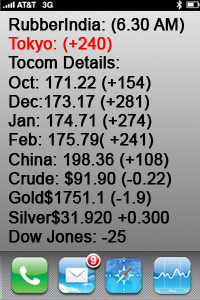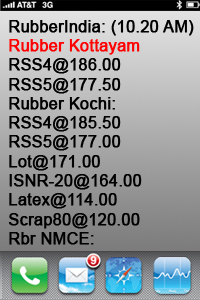
Date: December 5, 2023
Overview
The natural rubber market showed mixed trends globally on December 5, 2023. Japanese rubber futures gained slightly due to strong tire demand in China, but overall global prices remain under pressure because supply fears from Thailand have eased. These international price movements directly influence Tripura’s rubber sheet prices, as the state’s market is closely linked to global benchmarks.
📈 Price Trend Impact on Tripura
Although the report does not list exact local prices, the following global market factors help indicate the direction of Tripura’s rubber sheet prices:
1. Japanese Futures Influence (Positive Trend)
- Japanese OSE rubber futures rose 0.65% to 326.1 yen/kg.
- Short-term upward movement indicates mild support for local prices in Tripura.
However, the weekly decline of 4.90% limits the upward momentum.
2. Shanghai Futures Movement (Mixed Impact)
- May SHFE contract increased slightly by 0.2%, signaling some demand strength.
- Butadiene rubber prices fell 0.76%, showing weakness in synthetic rubber.
Since natural rubber competes with synthetic rubber, this could create mild downward pressure on Tripura sheet prices.
3. Singapore SICOM Prices (Slight Decline)
- SICOM Jan contract dropped by 0.1% to 170.2 cents/kg.
- This is a benchmark for Asian rubber prices → indicates softening trend.
4. Supply Conditions (Downward Pressure)
- Better weather in Thailand has improved supply outlook.
- More global supply usually leads to lower local rubber sheet prices.
- China’s seasonal production dip was not enough to tighten supply.
5. Economic Factors (Mixed Impact)
- Stable USD at 155.18 yen keeps international trade conditions steady.
- Japan’s Nikkei falling 1.4% reflects market uncertainty.
- Oil prices rising → could increase production & transport costs, indirectly supporting rubber prices.
6. Demand Conditions (Positive for Long Term)
- Strong tire manufacturing demand in China continues.
- Global rubber demand remains steadily growing, supporting long-term price stability.
📌 Overall Market Trend for Tripura Rubber Sheet (Prediction)
Based on global market signals:
Short-Term Trend (Next Few Days):
📉 Slight downward pressure
→ Due to improved supply and weak weekly global performance.
Medium-Term Trend (Next 1–2 Weeks):
📊 Stable to mildly positive
→ Driven by consistent global demand and China’s tire industry strength.
📝 Conclusion
For Tripura’s 1 Kg RSS (rubber sheet) market:
- Short-term prices may soften or remain stable, influenced by global oversupply and weak weekly futures.
- Long-term outlook stays positive due to growing global demand.
- Traders should watch international supply updates from Thailand and demand data from China, as both significantly influence local pricing.












